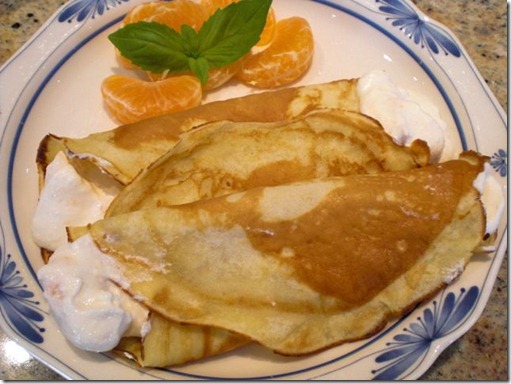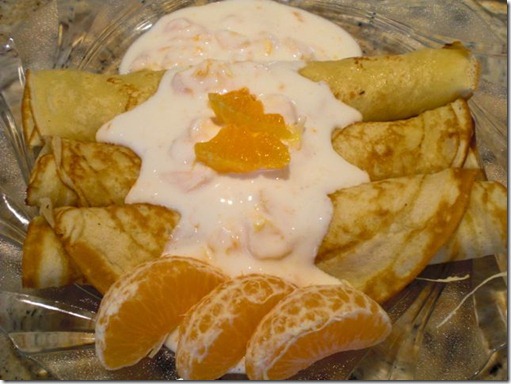We may have to change our blog title from “Izakaya” to “Breakfast”. This is another suggestion for breakfast from my wife. We had our share of pancakes especially in the summer when blueberries are in season. For this crepe, instead of cheese fillings such as Mascarpone, she suggested Greek yogurt flavored with Clementine orange.
Here is the crepe we had one weekend.

Next weekend, we had similar crepe but with a slight variation.

As usual, my wife made the batter and I cooked the pancakes.
Ingredients for crepe batter:
3/4 cup All purpose flour
1/2 Tsp. salt
1 Tsp. double-acting baking powder
2 Tbs. sugar
2 Eggs
2/3 cup milk
1/3 cup water
1/2 Tsp. vanilla
grated lemon rind
Sift together the flour, salt and baking powder and set aside. Mix together the sugar, eggs, milk, water and vanilla (make sure the sugar dissolves completely). Mix the wet ingredients into the dry ingredients.
Although some recipes call for resting the batter for 5 to 6 hrs or overnight (I suppose to relax the gluten and make tender crepes), we did not do this since we were rather hungry. Add more milk or water to get proper runny consistency.
Since we do not have a special crepe pan, rake or a crepe machine, I just used our non-stick frying pan. I preheated the frying pan for few minutes and added light olive oil (the amount of oil has to be just enough to coat the bottom). When it started to shimmer (but not smoke), it is the opportune time to add the batter. The batter has to be runny enough to spread very thin and the pan has to be hot enough that the batter can be spread thinly but the portion in contact with the bottom of pan immediately starts cooking. I tilted and turned the pan to spread the batter. I took the pan on and off heat to get the right heat level (#1). When the surface looked dry, I flipped the crepe using a spatula (#2). This definitely requires some practice. Just 10-15 seconds on the last side and the crepe was done (#3). I stacked them up on the plate (#4).
Yogurt sauce:
Greek yogurt (or regular yogurt drained using cheese cloth in the refrigerator over night)
Clementine orange, peeled and cut up in small chunks
Juice of the orange, add sugar to taste
This is quite good for a relatively low fat recipe. The original recipe calls for a mixture of Mascarpone flavored with fresh orange/orange juice as the stuffing but Greek yogurt and Clementine are good substitutes. You just can’t beat the texture and lovely mouth feel of a crepe. The mild vanilla flavor of the crepe went very well with the orange flavored yogurt.















